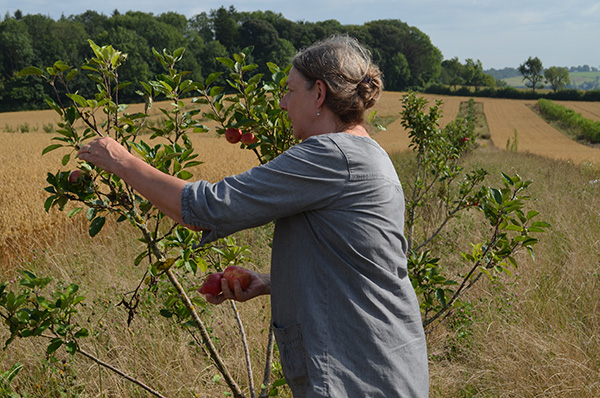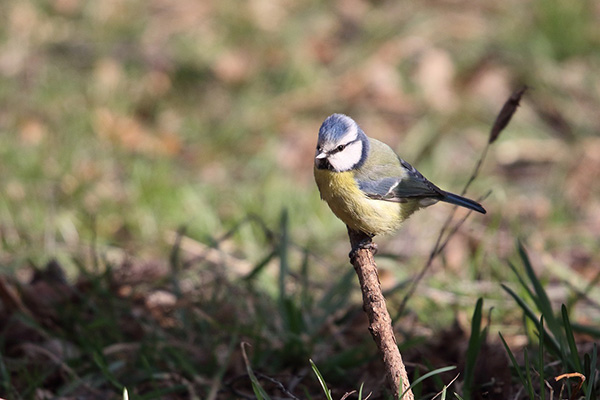- Soil Association
- Farmers & growers
- Low-input farming advice
- Agroforestry on your farm
- How silvohorticulture can benefit your farm

How silvohorticulture can benefit your farm
What is silvohorticulture?
Agroforestry is the practice of growing trees on your land and seeing them as part of the farming system.
Whether it be to improve the health of livestock who forage on the leaves, add a windbreak for your arable crops, or boost yields of fruit on your market garden – trees provide numerous advantages. Silvohorticulture relates to trees within a horticultural system.
Growing trees among your vegetable crops has the potential to boost biodiversity and resilience, and increase the wellbeing of those who work on the farm.
At the recent Agroforestry Show, we heard from Marina O’Connell from Huxhams Cross Farm in Dartington, Devon and Andy Dibben from Abbey Home Farm near Cirencester, on their own silvohorticulture systems and the benefits they’ve seen first-hand from introducing trees alongside their vegetable production.

Marina O'Connell, Dartington Farm, Devon
About the growers
Marina O’Connell farms at Huxhams Cross Farm in Dartington, Devon. Marina and her husband, Mark, originally bought a 4-acre plot in Dartington, where they established orchards and intensive cropping using permaculture techniques.
They established The Apricot Centre on this land in 2006 – a centre that works with children in a therapeutic or education context amongst orchards. In 2015, The Apricot Centre took on the tenancy of Huxhams Cross Farm as tenants for the Biodynamic Land Trust and worked with the local community to create a farm that would benefit the surrounding area, mitigate climate change, and boost biodiversity. Agroforestry was an important part of this equation and remains a central focus of the farm.

Andy Dibben, Abbey Home Farm, Gloucestershire
Similarly, agroforestry is central to the mission at Abbey Home Farm, where Andy Dibben works as Head Grower. Agroforestry has increased biodiversity on the farm, improved the wellbeing of those working on the land and provided more streams of income to the already abundant plethora of businesses running at Abbey Home Farm.
The farm is focused on providing all a customer needs from within the farm, with a farm shop, baker, butcher, dairy, forestry operation, market garden and field-scale veg operation on-site.
Both Andy and Marina have had silvohorticulture on their farms for nearly a decade. Both have seen similar benefits from implementing trees into their vegetable operations.
The benefits of adding trees to your vegetable farm
Silvohorticulture brings resilience to your farm business
1. Disease resistance
Having a diverse range of tree species in your agroforestry system makes you more resilient to diseases, as you are not dependent on one tree type for all of your needs. As we have seen with ash dieback, when destructive diseases attack certain tree species it shows how important it is to have a diverse range to keep the system strong.
2. Multiple sources of income
Different tree types offer multiple potential sources of income, with fruit and nuts being two of the most lucrative. At Abbey Home Farm, they produce all their own top fruit with 100 apple trees of 13 different varieties, including plums, cooking apples and pears.
At Huxhams Cross Farm, they too have damson and apple trees for fruit, and a wild harvest row – including trees such as elder, blackthorn and dog rose – that acts as a wind break. Marina says, “[silvohorticulture] increases your range of sales, which means more people would like to buy from you if they can buy their fruit, jam, eggs, and veg. It increases the range of product as well as the overall yields from the system”.
3. Reducing bought-in inputs
With less secure supply chains it is becoming even more important for farmers and growers to be able to reduce their dependence on bought-in inputs. Compost and woodchip are two inputs that can be costly yet are relatively easy to produce on-farm. Hazel and alder are planted in a Silvohorticultural design next to vegetable beds at Abbey Home Farm.
The wood is chipped straight on to the vegetable beds. Some of the ramial wood chip (made from medium-sized branches) is also rotted down for two years for market garden compost and the rest is left to rot down for three years to be used as propagation compost. A similar system exists at Huxhams Cross Farm. The hazel rows are coppiced every five years and put on to a ley as ramial wood chip across the farm.
Silvohorticulture brings biodiversity
1. Attracting beneficial predators
Having a wide variety of trees across your farm will result in a wider range of habitats for various beneficial insects and birds. Andy tells us that a great example of the benefits of planting trees close to vegetables is looking at the impact certain predators can have on the pests we see on vegetable crops. For example, one bluetit chick can eat 100 caterpillars in a day and there are, on average, ten bluetits in one nest – that’s around 1,000 caterpillars eaten per day.
Additionally, it’s not always about removing the pest entirely – having more trees is likely to encourage more birds of prey, such as kestrels, that will hover over the land and keep rabbits at the edges due to fear of getting eaten. Kestrels don’t eat rabbits – but the presence of more bird life above will dissuade animals such as rabbits from venturing into exposed areas of the farm. Andy says “boosting biodiversity is not a charitable activity”.

2. Tree pollen
Tree pollen provides a feeding source for predatory insects that feed on aphids. Creating a silvohorticulture design that includes pollen-producing trees throughout the season will ensure that you’re providing a feeding ground for insects that will help tackle aphid populations on your vegetable beds.
The best types of trees for pollen earlier in the season include apples, plums, hazel, alder, willow, and catkin-producing trees. Pollen from catkin-producing trees is also available at night, which is great for bats and moths. For trees that produce pollen later in the season – around May-June – plant Pussywillow, wild cherry, elder or spindle.
Silvohorticulture brings benefits for people and plants
1. Shade
When designing an agroforestry system in relation to horticulture, it is also very important to think about those working the land and how it might impact them. In the height of summer, shade from trees will provide a much-needed respite for busy growers. Just as added shade can reduce the stress on your vegetable crops, it can do the same for people too. This is important when we think of the future resilience of our farms, especially in relation to climate change.
2. Wind breaks
Additionally, trees can act as wind breaks. Less harsh winds will result in lower moisture loss from plants and soil, resulting in less time spent trying to water across the farm during the hot summer days. This is also beneficial in mitigating climate change as less water and topsoil are lost. Wind breaks can also make a job much easier, as a farmer doesn’t have to contend with high wind speeds while driving a tractor, planting, weeding or harvesting.
3. Farming in manageable blocks
As farmers can design their own agroforestry systems, they can create them in a way that suits their ways of working. At Marina’s farm, the market garden is split into smaller bed blocks that are divided by trees. Psychologically, this has had a great impact on those working the land, as they are able to complete tasks quickly and not get overwhelmed by large, long beds with little shade and high winds.
At Abbey Home Farm, agroforestry is planted right outside their farm café window. This also has the added benefit of providing customers with beautiful spring blossom and relaxing tree-lined views that complement their farm experience.
